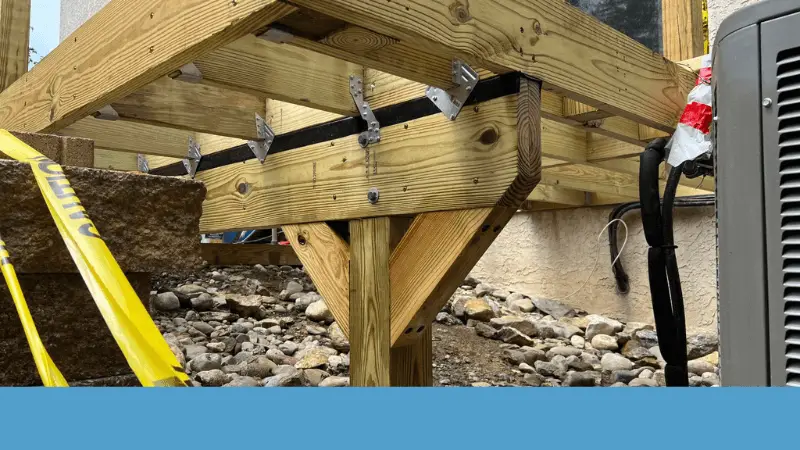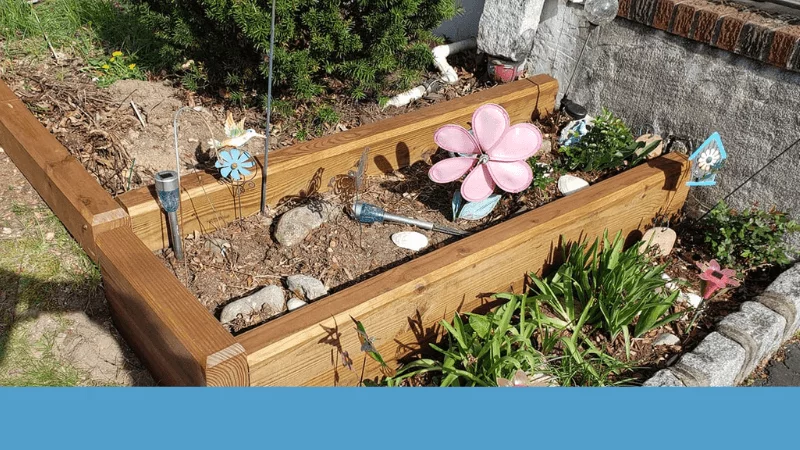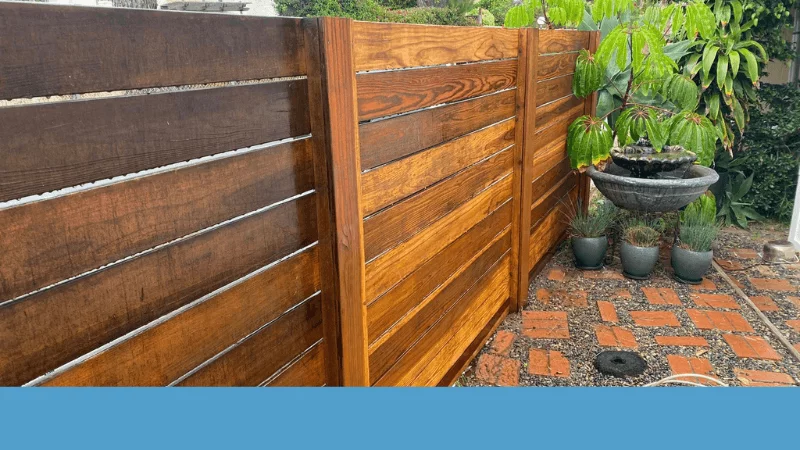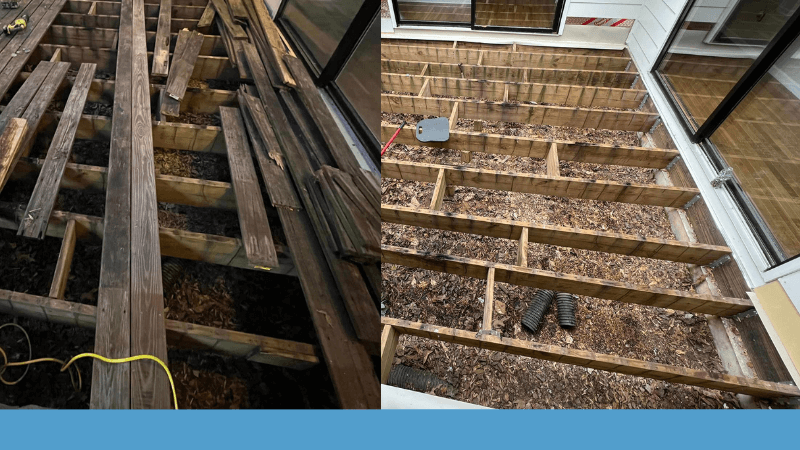Wood rot caused by ground contact is an intriguing phenomenon that defies common logic. It’s somewhat perplexing to consider that wood, which originates from and spends most of its life rooted in soil, is prone to decay when in contact with it. Unlike trees, wood lacks the properties necessary for sustainable rejuvenation, rendering it highly susceptible to rot when exposed to the ground for extended periods.
Whether you’re constructing structural posts, fence pickets, garden boxes, sill plates, or deck posts, your wood is bound to come into direct contact with the soil, significantly increasing the risk of decay. Fortunately, this comprehensive guide aims to provide you with the ultimate solution for treating wood in ground contact. We will take an in-depth look at all the nitty gritty details pertaining to ensuring your wood remains intact for longer despite ground contact.
Ground Contact Risk Factors

Ground contact leaves wood susceptible to various risk factors that magnify the material’s decay hazard. These include:
WHC (Water Holding Capacity) & MC (Moisture Content)
The most significant factors are soil moisture contact and water-holding capacity. Even dry soils have a substantial water-holding capacity that enables them to retain moisture for extended periods of time. Despite varying seasonal and daily weather patterns, most soils retain a tangible amount of moisture content that is guaranteed to negatively impact wood. Once wood gets in contact with soil for a long, water gradually enters the wood grains causing it to expand and contract when dry. This irregular movement compromises the wood’s structural integrity as it brings about cracks and warps.
Wood Damaging Microorganisms
Another essential risk factor is the presence of wood-damaging microorganisms in the soil. What’s worse, the makeup of these microorganisms is unpredictable, making it impossible to avoid them. Research shows that the long-time presence of high moisture content creates a favorable environment for wood-damaging microorganisms to thrive. Specifically, soil contains wood-decaying microflora such as bacteria and soft-rot fungi. It also contains wood-rotting fungi, namely white rot and brown rot basidiomycetes, and wood-burrowing insects, such as termites.
Best Wood for Ground Contact
Are there woods that are more suitable for ground contact and work better with applications? The answer is a resolute yes! There are certain species that are more durable and sturdier than others. However, while robustness is an added advantage for ground contact wood, the key to proper preservative performance is penetration.

Protection from soil hazards will only take place in areas penetrated by the chemical. As such, you need to prioritize the most penetrable timber before considering the wood’s sturdiness. Woods with the least amount of extractives, meaning they have the least ability for natural decay resistance, are the least difficult for preservative penetration into the heartwood.
Noteworthy, you should also avoid picking extra thin woods due to limited durability. Although not a priority, the wood’s internal structure is also an important consideration. In this regard, the top three wood species include:
Redwood
This is among the oldest wood species in the world, with some trees living for up to 100-150 years. In essence, this longevity boils down to the wood’s resilience as it is able to withstand more elements than the ordinary tree. Redwood, particularly its centermost part (heartwood), contains extractives that give this material highly beneficial attributes. Redwood has a low shrinkage rate making it resistant to moisture damage, has a high resistance to decay, and has superior mechanical properties to most ordinary trees.
However, what makes it the perfect wood for ground contact is its ease of preservative penetration. This timber is ranked as one of the least difficult softwoods to treat using non-pressure means. Nonetheless, you need to take extra precautions to circumvent its high extractive content for maximum preservative uptake. It is advisable to immerse the wood into the preservative for several days to give it ample time for penetration, and air-drying it later to ensure no more drying post-penetration.
Cypress Wood
Did you know…?
The oldest tree in the world is an ancient bald cypress tree popularly known as ‘The Great Grandfather’. This tree is located in the Alerce Costero National Park in Chile and is estimated to be around 5484 years old. What’s more, its trunk is approximately 4 meters thick, also making it one of the biggest trees in the world.

As evidenced by ‘The Great Grandfather’, cypress trees are arguably the most long-lasting and durable trees in the world. The same can be said about the tree’s wood, making it a relatively good choice for outdoor ground-contact projects.
First, cypress wood grains are very tightly packed, leaving little to no space for water to seep into the wood. Consequently, cypress wood is water-repellant. Secondly, cypress wood contains a natural preservative that protects it from wood-damaging insects and rots. This high resistance is in part due to the aforementioned preservative which is a natural oil referred to as cypressine. Lastly, cypress wood is exceptionally sturdy. It is a hard-wearing material that is not easily destroyed. With such qualities, it is evident that cypress is a very formidable choice for ground contact projects. Using a wood preservative will add to the wood’s resistance, boosting its ability to withstand soil hazards.
Despite these natural properties, just like Redwood, cypress is one of the few kinds of wood that fits perfectly into ground contact work due to its ease of preservative penetration and structural attributes. The wood, particularly Bald Cypress (taxodium distichum), is ranked as a moderately difficult softwood in the case of heartwood penetration. This means you will fully treat the wood and still enjoy a sturdy performance capable of withstanding all hazard factors for decades. However, to ensure maximum penetration, dip the wood into a preservative for a few days and air-dry it.
Red Oak
This is a common tree in the US, arguably the most common hardwood in the country. It is a ubiquitous fixture in most American homes since it is readily available, moderately priced, strong, and exceptionally handsome. Its heartwood comes in a light brown hue with a reddish cast, making it perfect for outdoor rustic appeal.

It has poor natural insect resistance and its internal structure is very porous due to its uneven texture. Its pores are very large, meaning you should not have any trouble treating this wood using non-pressure application methods. It is ranked as one of the easiest hardwoods to treat. Simply ensure you give the preservative ample time to penetrate deep into the wood and air-dry it. Also, it would be prudent to add a clear topcoat to protect the wood from the elements, most notably sunlight, and water.
What Is Pressure-Treated Wood?
Pressure-treated wood is a timber that has undergone chemical treatment to protect it from wood-damaging pests, rot, and decay. Ideally, wood is placed under pressure to ensure the chemical is absorbed into the wood and penetrates through its grains for maximum protection. Treating wood gives it the ability to resist pests and reduce decay, hence increasing its longevity. The most commonly used chemicals for contact wood treatment include copper azole, alkaline copper quaternary, and micronized copper azole all of which are copper-based.
The American Wood Protection Association has set standards for treated wood to ensure there are specific categories purposely designed for specific applications. Specifically, there are twelve ‘Use Codes’, abbreviated as UCs, designed for different levels of utilization. Ground contact wood levels include UC4A, UC4B, and UC4C. Class A is meant for general ground contact use, class B is meant for heavy ground contact, and class C is meant for heavy ground use. In most cases, timber companies will tag the wood with their respective classifications to make it easier for buyers to identify the most suitable wood for their intended ground contact use.
| Use Code (UC) | Description | Purpose |
| UC4A | Class A | General ground contact use |
| UC4B | Class B | Heavy ground contact use |
| UC4C | Class C | Heavy ground use |
Pressure Treated vs. Ground Contact Lumber
The main difference between pressure-treated and ground-contact lumber is basically the level of chemical treatment. Although both types of wood are infused with chemicals, ground contact timber undergoes high-level treatment. Ideally, the term ground contact implies direct and permanent soil contact. This means exposure to high moisture levels, insects, and fungi, leaving your wood highly susceptible to deterioration.
Therefore, while pressure-treated wood is industrially infused with chemical preservatives, wood intended for ground contact is also treated with the same chemicals, but in significantly higher amounts to ensure it has sufficient protection against the aforementioned hazard factors.
Best Below-Ground Preservatives
So, which is the best below-ground preservative in the current market? Should you pick an oil-based or water-based preservative? Which one works best for ground contact use? These are some of the questions that are likely to give you a headache next time you are out shopping for a ground contact wood preservative. Lucky for you, we have compiled a list of the best options available. These include:
Rust-Oleum Copper Green
Introducing Rust-Oleum Woodlife CopperCoat Green Wood Preservative, a top-notch solution with an advanced, EPA-registered formulation. This preservative is specifically designed to provide exceptional defense against ants, beetles, termites, mildew, mold, and decay, ensuring your wood stays protected for years to come.
This is arguably the best below-ground preservative in today’s market. It stands out as a highly effective wood preservative.
It is made using a formulation that enables it to protect wood against decay, resist mildew, and resist mold.
It is also a highly potent insect repellant with the ability to protect wood against ants, termites, beetles, and other tiny wood-burrowing creatures.
Another notable feature of this wood preservative is its ease of use. You can apply it using a brush, roller, or simply dip the wood into the liquid. Notably, allow the wood to sit for at least 24 hours to dry fully before applying a topcoat or installation.
On the flip side, this copper coat has a strong odor that might be a problem for people with sensitive noses. Also, it leaves the wood with a shade of light green that might be a turn-off for individuals looking to attain a rustic aesthetic in their outdoors.
Tenino Copper Naphthenate
The oil-borne preservative is formulated with copper naphthenate blended in a hydrocarbon solvent, providing unparalleled protection against wood-burrowing insects and water-related damage. Whether it's fence posts, railway crossties, highway buildings, or utility poles, this powerful solution is designed to safeguard your large timber constructions.
Another good option available on Amazon is the Tenino copper Naphthenate wood preserver. Not only is it affordable and easy to use, but it is also very effective when it comes to repelling wood-destroying insects and fending off fungi. It specifically works best against dry wood termites, powder post beetles, carpenter ants, and subterranean termites.
Tenino Copper Naphthenate is also a viable option for wood protection against moss, mildew, rot, and mold, which are notorious for compromising wood’s structural integrity.
This wood preservative is also easy to use as no diluting or mixing is needed. It is ready to apply and does not take too long to dry.
Green Products 33001 Copper Brown Preservative
The Green Copper Brown Wood Preservative is specifically formulated to protect your wood from the harshest weather conditions. It offers excellent resistance against mildew, mold, and insects, acting as a potent repellent. By chemically reacting with the cellulose in the timber, this preservative ensures long-lasting effectiveness without leaching, while also providing an additional layer of sealing for enhanced wood protection.
The downside is its green color, which can be a turnoff especially if you are going for a natural, rustic aesthetic. Fortunately, this issue can be solved
How to Treat Wood for Ground Contact
Non-Pressure Application
The most convenient option is by non-pressure application of a wood preserver. As mentioned above, Rust-Oleum Copper Green is arguably the best preservative in the current market. It is recommended that you use the dip method as it gives the chemical ample time to penetrate deep into the wood. The dip method entails the following steps:
- Pour the green chemical into a container
- Dip the wood into the preservative for several days.
- Afterward, allow it to air-dry to facilitate maximum penetration and ensure the wood does not dry any further after penetration. Without air-drying, checks might open up on the wood’s surface, exposing the untreated bits.
- Once it is dry, you could also apply a topcoat for added protection before installing your wood in the ground.
- It is also advisable to touch the wood’s end grain as detailed in this video.
Use of Diesel
Traditionally, individuals would use diesel oil applications as the main means of treating wood for ground contact. To get the best results using this method, follow these steps:
- Pour 3 ⅓ quarts of your diesel fuel into a large container.
- Get Copper Nitride from your nearest retailer and pour 1 quart into the container. This amount will ensure you attain the required 2% copper nitride concentration.
- Mix the liquids thoroughly using a stick.
- Using a brush, gently paint the mixture onto your wood surface. Ensure you cover all corners.
- Let the wood sit for up to 48 hours to ensure it is fully dry.
- Install your pre-treated wood.
How Long Does Ground Contact Wood Last
Ground contact pressure-treated wood can last for at least 40 years, while above-ground pressure-treated wood can last for up to 10 years. How long ground contact wood lasts largely depends on the amount of chemicals used to treat it. Case in point, above-ground pressure-treated wood contains a significantly small amount of chemical preservatives than ground-contact pressure-treated wood.

As such, ground-contact wood lasts longer than its above-ground counterparts. On the other hand, studies performed by USDA’s Forest Service department show that ground-contact wood preserved using copper Naphthenate, ammoniacal copper zinc arsenate, chromate copper arsenate, or pentachlorophenol have a longer longevity than those treated using creosote-based preservatives.
In specific, the latter allows wood to last for around 50 years while wood preservatives made using chemicals from the former batch can last for up to 60 years. Copper Naphthenate provides the wood with the longest longevity as it can last for as many as 65 years. With that in mind, your main priority is durability, it would be best to go for a copper Naphthenate wood preserver for your next ground-contact wood installation.


